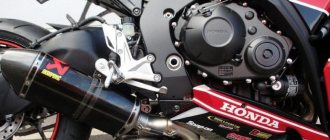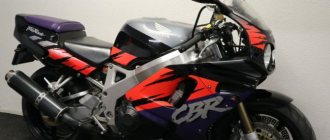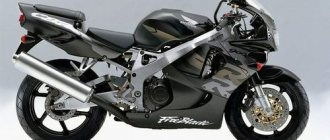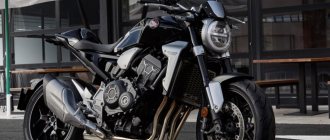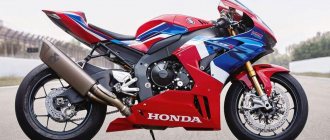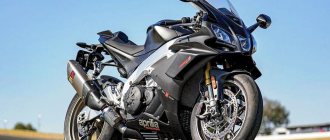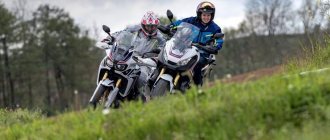Honda CBR1000RR-R Fireblade SP
Honda's history is deeply rooted in racing, and the Honda CBR1000RR-R Fireblade SP sums up everything the company has learned over the years creating sports motorcycles. Of course, the Reds have built countless millions of utilitarian motorcycles because that's their main source of income. But Honda never forgets its essence and constantly tests itself and its technology in races.
Honda CBR1000RR-R Fireblade SP 2021
This is what makes this bike so complete and real. Everything about the new Fireblade is designed to deliver fastest lap times and reaffirm Honda's dominance in World Superbike. This bike combines the most important highs: power, torque, speed - and the most important lows: weight and inertia, and adds the latest MotoGP technologies to them. This bike looks like it came off the same hand-crafted assembly line as the GP shells, and Honda says the new model's performance matches that of the 2021 RC213V-S MotoGP replica. The difference with the latter is that the Fireblade is much more affordable - and will appear in small numbers in June 2021 as a MY21 model.
The new model will be the most powerful, most track-focused Fireblade ever (according to Honda). Claimed 214 hp The 14,500 rpm and 200 kg curb weight for the European version will add approximately 9.7 percent of the power-to-weight ratio over the previous version, and a whopping 79.5 percent increase over the original 1992 CBR900RR. True, the American version, regulated almost beyond recognition, will produce 186 hp. at 12000 rpm.
I was lucky to attend the international presentation of the new CBR1000RR-R Fireblade SP, where we were shown the European version of the device. Each of us was given four 25-minute races on one of the most famous tracks where the MotoGP stages were held. And if you had any doubts about Honda's intentions, keep in mind that the bikes at the press ride were shod with Diablo Superbike racing slicks and were kept in check by Pirelli employees.
Sports equipment Honda Fireblade SP
Sitting on the thin, narrow seat, I felt like I was driving an authentic sports car: a nice aluminum yoke, keyless entry (the CBR uses a wireless key fob and an ignition button next to the dash), and a 5-inch full-color TFT display displays exactly the amount of information that important when you're driving.
Ergonomics
Ergonomics have become a little more aggressive. The 2020 Fireblade SP's pegs are 21mm taller and set back 43mm further, providing a lower riding position that I absolutely approved of during the ride. The clip-ons have also moved, but not for my taste: they are 17 mm lower and more forward, forming almost a drag bar. As a result, the load on the wrist is increased both during heavy braking and during powerful acceleration when “pulling up” on clip-ons. By the end of the day, regardless of your physical fitness, you get tired of it. Luckily, clip-ons aren't too difficult to replace.
Acceleration and character
Of course, the CBR has the impressive acceleration and overall character you'd expect from a modern sportbike. All this is enhanced by a powerful digital package: electronic throttle, electronic throttle, nine levels of Honda Selectable Torque Control (also known as traction control) and five traction modes.
Honda CBR1000RR-R Fireblade SP 2020
I started with the least torquey and most "precautionary" option, methodically going through everything until I settled on traction mode number 1 - the most powerful, and set the traction control to position 2 (the highest level of intervention is achieved in position nine). For me, these turned out to be the optimal settings for quickly and comfortably exiting corners without reducing throttle sensitivity.
To get a feel for the friendliness of the 999cc engine, I turned off the traction control and wheelie control completely for the last five laps, and felt exactly the same confidence when accelerating as I did with the electronic aids engaged.
Second-gear acceleration is enough to knock the pants off you, and low- and mid-range pull is powerful yet surprisingly linear. Then it quickly increases around 10,000 rpm, and the engine drags until the cutoff (which has become higher - 14,500 versus 13,400). And on the long straight of the track, 299 km/h means switching to fifth.
But as we know, a superbike is not just about horsepower. It's also a powerful blend of chassis, engine and electronics working together as a united front. And it's this mixture that Honda has improved the most on the new Fireblade - it's impossible to single out a single aspect that has improved. Yes, the engine makes more power, but without the proper chassis and electronic gizmos, power alone doesn't mean much these days.
Chassis
And when it comes to the CBR1000RR-R Fireblade SP chassis, Honda has struck a striking balance. A new twin-spar frame and swingarm with revised stiffness characteristics make the Fireblade an extremely serious projectile not only on straights, but also in corners. The sportbike shines in shifts from side to side, requiring minimal effort to change direction and easily refines the trajectory in turns.
Literally - wherever you look, there you go, without any difficulties. A real track machine to the core.
Of course, the top-end suspensions, the Öhlins NPX Smart EC 2.0 semi-active gas fork and TTX 36 Smart EC shock, play an important role in the handling, providing excellent feedback and precision in corners from entry to exit. Both suspensions are easily tuned via the Objective Based Tuning Interface, where they are available in six modes: three automatic semi-active and three manual, in which the suspension characteristics remain constant if the rider knows best what he needs.
Driving laps around the track in the suspension's Auto mode, I felt a slight but undesirable looseness, most noticeable in the form of a squeezing of the rear under acceleration as the system changes its smoothing characteristics. I overcame this by setting the boost support to two points (out of five available). And although semi-active suspensions have come a long way in development, and work well on the track, today I prefer the clarity and stability of the characteristics. The latest Öhlins Smart EC are close to perfect - but not perfect.
Having switched the pendants to manual mode, I found what I was looking for. Having recorded the smoothing characteristics of both suspensions, I obtained excellent stability of their operation and felt that nothing better could be asked for.
Stability, especially under braking, has been excellent, and the front pair of Brembo Stylema calipers on 330 discs perform exceptionally well, with no trace of early ABS activation or brake slip when overheating, as on the previous version.
Model overview
Honda developers and HRC engineers have created a new inline 4-cylinder engine for the CBR1000RR-R. This compact engine is designed as an "ultra-short stroke" engine with the same bore and stroke as the RC213V, and features the latest combined gear and chain drive system, short rocker arms, titanium connecting rods, and friction-reducing technologies like the RC213V-S. , piston injectors with ball and bypass valves in the lower part of the cylinder cooling jacket.
An air intake located at the front of the fairing provides sufficient pressure in the frame air duct passing through the steering column - directly to the air filter. The 4-2-1 exhaust spider has an oval cross-section and, like the muffler, was developed in collaboration with Akrapovic.
The CBR1000RR-R engine develops a torque of 113 N•m. at 12,500 rpm, and reaches peak power at 160 kW at 14,500 rpm.
The Throttle By Wire electronic throttle system has been improved to improve the pilot's feedback to the engine, 3 piloting modes available by default, differing in Power (power limitation), Engine Brake (engine braking level), Wheelie Control (lift control) front wheel) and optimized Honda Selectable Torque Control (HSTC) settings. The electronics set also includes a customizable starting assistance function – Start Mode.
An all-new diagonal aluminum frame connects to the motor, which is the top mounting point for the rear shock; The rear wheel swingarm is longer and has a design similar to that of the RC213V-S. The stiffness balance and weight distribution as well as the steering geometry have been carefully optimized to extract maximum usable engine power in terms of providing better levels of front and rear wheel grip and better feedback for the driver.
Showa Big Piston Fork (BPF) with a diameter of 43 mm complete with a Showa Balance Free Rear Cushion Light (BFRC-L) rear shock. The front discs are larger in diameter and work with new 4-piston Nissin calipers, and the ABS system is configurable for both road and track driving. The new rear tire size corresponds to the racing standard - 200/55-ZR17.
The 6-axis Inertial Measurement Unit (IMU) provides precise measurements of the motorcycle's position in space for a clear assessment of riding dynamics and provides data for the operation of all electronic systems. It also controls the operation of the new 3-level rod-type steering damper (Honda Electronic Steering Damper, or HESD).
Honda's MotoGP prototype RC213V inherits some of its ultra-sleek aerodynamics from the new CBR1000RR-R, including a set of winglets - a system of flaps designed to increase downforce and improve braking stability. The pilot's position behind the wheel is now more collected.
The fully configurable 5-inch TFT display offers intuitive control of motorcycle settings via a 4-way joystick located on the left console. The Honda Smart Key keyless entry key fob has become standard for modern motorcycles.
2021 Honda CBR1000RR SP and SP2 inside
Honda launched the CBR1000RR in SP and SP2 variants at Intermot this month. The new bike features a number of upgrades including an Ohlins electronic suspension system, a full electronics package and even a titanium fuel tank. Below are images of various elements to give you an idea of the new CBR1000RR.
Honda says the new CBR1000RR returns to the principles of the original CBR900RR introduced in 1992. In this case, the main emphasis is on the power-to-weight ratio, cornering, acceleration and braking. The concept behind the design of the new motorcycle is “A New Level of Total Control”. The main updates to the motorcycle include a 5-axis inertial measurement unit (IMU), servo-motor throttle control that allows for a number of additional features, as well as a new IMU-controlled ABS system.
Enhanced controls include: Ohlins Master Adjustment Interface, which allows fork compression, damping and shock levels to be adjusted through preset or manual settings, and in addition HSTC, which utilizes IMU, ECU and Throttle systems By Wire (throttle servo), and provides increased control of lifting the rear wheel.
The cylinder diameter and piston stroke remained the same - 76 by 55.1 mm with an engine power of 999.8 hp. The crankshaft, valvetrain and transmission are made from higher grade materials to match the increased power output.
The clutch system has been completely redesigned. It now uses one die-cast aluminum clutch disc and one clutch center, requiring less shift lever force. Braking function remains the same as before, but some steel parts have been replaced with aluminum to reduce weight.
The entire engine casing has also been redesigned. The clutch system housing is made of aluminum, while the ignition system housing is made of magnesium alloy. Other weight saving features include different bolt lengths, water hoses and hose clamps. Overall, the engine is 4.4 lb (1.6 kg) lighter than before.
The throttle body has increased in diameter from 46 to 48 mm. The servo system uses an acceleration sensor (APS) built into the right throttle lever to send an electrical signal to the ECU, which controls the throttle using an electric motor.
The return spring and other mechanisms inside the APS, which replicate the natural feel of cable-operated throttle control, were developed specifically for the CBR1000RR.
The piston wall thickness has been optimized and they have a new head design. Compression ratio increased from 12.3:1 to 13:1. The grooves on the outside of the piston ring have also been redesigned to improve sealing and efficiency. The SP2 cylinder head features a 1mm larger intake valve diameter (31.5mm) and a 1.5mm larger exhaust valve diameter (25.5mm), with an intake/exhaust angle of 10°/12° instead of 11°/11°. The valve inclination is the same and corresponds to the width of the cylinder head. In the SP2 variant, the piston heads are heat treated to increase the strength of the piston bushing area, which uses a 2.5mm shorter piston pin (making each cylinder 8 grams lighter). To make room for the taller outer diameter of the crankshaft, the valve lifter in the SP2 has grown by 2mm (to 28mm), while overall height and thickness have been reduced to reduce weight.
Valve and cam lift timing have also been revised, resulting in increased power and higher rpm.
The titanium muffler is more than 6 pounds (2.2 kg) lighter than previously. The 4-2-1 exhaust system design includes an exhaust valve.
Honda claims improved bottom-end power and torque. At the same time, maximum power increased by 11 hp. (up to 189 hp) at 13,000 rpm. The claimed torque peak at 11,000 rpm is 86 lb-ft (11.0 kg-m).
The use of a servo allows the use of a power selector that provides five levels of “power character”. Level 1 gives maximum power at all six speeds. Power in Level 2 is controlled at each speed to achieve a smooth throttle feel during acceleration and braking. Level 5 provides the highest control for the smoothest throttle response. All levels give the same throttle response when opening begins.
The new ABS system, like the IMU, uses information from the front and rear wheel speed sensors to control braking force accordingly.
Using bi-axial acceleration information from the IMU, the ABS system calculates the acceleration of the motorcycle's center of gravity in and perpendicular to the uphill direction, using the front wheel as the zero point. Based on this information, ABS can control rear wheel lift and counteract the tendency of the rear of the motorcycle to spin around the front.
ABS also allows braking on hard surfaces by using the motorcycle's lean angle and front wheel speed reduction, as well as the front/rear slip ratio of the motorcycle to change the ABS activation threshold.
The Suspension Control Unit (SCU) receives roll, yaw and pitch angle information from a Bosch MM5.10 IMU 5-axis gyro (weighing just 40 grams). These 5 axes include 3 acceleration axes and 2 angular velocity axes. The IMU is located at the center of gravity of the motorcycle. It also collects information about wheel speed, engine speed, braking force, and throttle angle from the FI-ECU, and, depending on the suspension mode selected by the rider, provides optimal compression ratio and damping force (adjusted using a stepper motor) during normal driving, as well as during sudden acceleration, braking and turning.
The rider can choose from three active modes and three manual modes for the Ohlins electronic suspension. When the active mode is set, the damping force is controlled and optimized to suit the driving conditions: A1 (speed), A2 (fun) and A3 (safety). In active modes, the rider can make minor adjustments. Manual modes M1, M2 and M3 allow full adjustments.
There are five driving modes in total, three of which are pre-set for different driving purposes and electronic suspension performance, while the remaining two allow manual adjustment.
The HSTC system used on the CBR1000RR SP and SP2 is an improved version of the system found on the RC213V-S. There are two methods involved in torque control. The first method compares the rotation speed of the front and rear wheels, while the second method uses the roll angle. The IMU detects the chassis' yaw and lift yaw rates, as well as pitch, roll and vertical acceleration. The device then calculates the engine torque control angle, maintaining rear wheel traction at the required level.
When the FI-ECU detects the rear wheel accelerating (and the front wheel decelerating), it uses a servo motor to change the throttle position, reducing power and keeping the front wheel on the ground. Therefore, you can use the throttle as much as possible without fear of the bike lifting onto the rear wheel.
The new TFT display panel includes speedometer, tachometer, gear position indicator, quickshifter, coolant temperature indicator, distance traveled and two trip meters. The Shift-Up indicator is a horizontal line of 5 white LEDs located at the top. When the engine speed exceeds the user set speed, the LED indication changes from solid to flashing. On the upper center display, the driver can select the Shift-Up indicator speed setting output, grip angle, battery voltage, calendar or user-defined text. The instrument panel has three output modes: Street, Circuit and Mechanic, each of which displays information relevant to use. Street mode displays three driving modes (1-3 and USER 1-2) and each parameter setting P (power), T (HSTC), EB (engine braking) and S (suspension).
In Circuit mode, in addition to what is displayed in Street mode, the average time on the track, the number of passes of the track and the difference from the best pass of the track are shown.
Mechanic mode shows the digital tachometer, gear position, clutch angle, coolant temperature and battery voltage.
The titanium fuel tank is manufactured using an ultra-deep drawing process, is nearly 3 pounds (1.3 kg) lighter than the previous steel tank, and promotes mass centering.
Fork rake and trail remain the same at 23.3°/96mm, but the stiffness balance of the hollow cast aluminum frame is significantly increased. The frame walls weigh 300 grams less. While lateral stiffness remains unchanged, the frame is 10% more torsionally flexible, resulting in faster chassis response. Yaw moment of inertia from heading is reduced by 15%, and lifting moment of inertia by 10%. Frame changes are complemented by Unit Pro-Link hybrid aluminum construction, which adjusts the thickness of each section, also reducing weight by 100 grams while maintaining lateral rigidity and increasing torsional rigidity.
The Brembo monobloc radial quad brake caliper uses newly developed high friction brake pads - they perform better at high temperatures than standard pads and are more suitable for aggressive motorcycle riding. Aluminum wheels with five Y-spokes reduce weight by about 100 grams.
The cast aluminum subframe has also been redesigned, with a slimmer structure that is both stiffer and 800g lighter. It promotes mass concentration and a neutral handling feel while increasing flexibility. Other sources of weight savings include the lithium ion battery, which is two pounds (0.9 kg) lighter than a traditional lead-acid battery.
The upper fairing has become 24 mm narrower, but during normal movement the air is evenly distributed between the rider’s shoulders, back and sides. The middle fairing is also 18mm narrower, and the knee compression area has been reduced by 15mm on each side.
Marchesini wheels in the SP2 reduce inertia by 18 percent at the front wheel and 9 percent at the rear.
Key Features
Engine
- Short-stroke inline-four engine produces high power at high rpm
- The timing gears and electric starter are located on the clutch shaft
- Internal friction is reduced thanks to a diamond-like carbon coating on the camshaft lobes and bypass passages in the lower part of the water jacket
- Valve rockers, titanium alloy connecting rods and forged aluminum pistons help reduce internal weight
- RamAir air intake tunnels pass through the steering column
- Muffler with titanium alloy body developed jointly with Akrapovic
The CBR1000RR-R's 1000cc inline-four engine is a completely new development, developed in collaboration with the HRC MotoGP team's engineers. It produces a maximum power of 160 kW at 14,500 rpm and a maximum torque of 113 N•m at 12,5000 rpm.
To achieve these parameters it was necessary to increase valve size, combustion efficiency and reduce internal friction, so the RR-R engine has the same “ultra-short-stroke” dimensions - 81 mm cylinder bore and 48.5 mm piston stroke - as the RC213V engine. This is a radical departure from the previous design, with dimensions of 76 x 55.1 mm, and the largest cylinder bore of any 1000cc inline-four.
The compression ratio is 13.0. The diameter of the intake valves is 32.5 mm, the exhaust valves are 28.5 mm. Instead of the previous cup-shaped pushers, short rocker arms were used, which reduced the inertial masses by approximately 75%. Internal friction is also reduced by using a Diamond Like Carbon (DLC) coating on the camshaft lobes - like on the RC213V-S. This process, which reduces friction losses by 35%, is the first to be used on a mass-produced motorcycle. To reduce crankshaft deflection (due to inertia and forces during the power stroke), the main bearing beds have been increased in size, and the thickness of the crankcase walls has been optimized.
The overhead camshafts are driven by a new patent-pending mixed gear and chain drive system. To support high-lift, high-speed camshafts, the chain is driven from a gear on the crankshaft via a gear on the countershaft, allowing the chain to be reduced in length.
Forged lightweight connecting rods and connecting rod caps are made from TI-64A titanium alloy (developed by Honda) and are 50% lighter than those made from chrome-molybdenum steel. Bolts made of HB 149 chrome-molybdenum-vanadium steel (also developed by Honda) are screwed into the body of the connecting rods, without nuts.
To increase the durability of the friction surfaces, the same techniques are used as on the RC213V-S: the bushings of the small connecting rod heads are made of C1720-HT beryllium bronze (providing reliability at high speeds), and the surfaces of the lower connecting rod heads are coated with a DLC coating.
The pistons are forged from A2618 aluminum alloy (the same as on the RC213V-S), which not only improves reliability, but also reduces the weight of each piston by 5%. To ensure resistance to wear at high speeds, the piston skirts are coated with an Ober coating (based on Teflon and molybdenum), and the piston pin snap ring grooves are coated with a nickel phosphate coating.
To combat the increase in piston temperature, multi-nozzle nozzles are used, which spray oil in different directions with each stroke. At low speeds, when there is no need for such cooling, ball valves in the injectors close the oil lines to prevent a drop in pressure in the lubrication system and reduce friction.
Air enters the engine through the ram-air intakes located on the fairing in the high-pressure area, the size of their openings is the same as on the racing RC213V. Ribbed "turbulators" on the right, left and top inlet planes provide maximum filling with minimal impact on handling. The carefully calculated angle of inclination of the internal walls of the air ducts ensures stable flow at high speeds and during acceleration.
To ensure stable dynamics over a wide speed range, compressed air enters the air filter directly through the steering column, close to its axis. This direct route is possible thanks to Honda's Smart Key system (which eliminates the need for a traditional ignition lock cylinder) and a 25° steering column angle.
The dirty side of the air filter is enlarged by 25% and angled to straighten airflow. On the “clean” side of the air filter, air along with fuel sprayed by the upper nozzle enters a bell-shaped eccentric flare. This ensures a minimum drop in incoming air pressure and more efficient filling results in improved dynamics.
To ensure the required air volume, the diameter of the throttle bodies has been increased from 48 to 52 mm. For the sake of smooth flow, as well as to reduce intake pressure drop, the intake tract from the throttle valves to the intake valves has an oval internal cross-section.
The intake valve angle has been reduced from 11° to 9°. This improves combustion efficiency due to the reduced surface area of the combustion chamber. The efficiency of the gas flow in the inlet pipes has been increased by approximately 2%.
Intake volume (the volume of the intake tract between the throttle valves and valve seats) has been reduced by 13% to improve throttle response. The throttle shafts are now made from high-strength stainless steel (rather than brass), reducing flex and friction during operation - providing a more direct connection to the driver's right hand.
On the opposite side to the intake, the four exhaust pipes have an optimized size and oval cross-section to improve gas flow. The diameter of the catalyst assembly has been increased by 10 mm, but careful consideration of the wall thickness has allowed the increase in mass to be kept to a minimum.
The muffler was created jointly with the Akrapovic company. It is made of titanium alloy, and its small size and low weight contribute to mass centralization and allow for increased lean angle in right-hand corners. The power valve, which allows for increased torque at low rpm and increased power at high rpm, was also developed in conjunction with Akrapovic. A special patent-pending blocking valve, when closed, prevents exhaust gas from escaping, reducing noise levels while allowing the internal volume of the muffler to be reduced by 38% compared to the existing design.
A key factor in increasing the operating range of the RR-R engine is reducing internal friction wherever possible. To reduce the deformation of the cylinder walls (and thus reduce friction), the cylinder block is equipped with built-in bypass channels in the lower part. Cooled fluid from the radiator circulates in the main water jacket, and uncooled fluid is used in the lower part of it. This ensures a uniform and lower cylinder wall temperature compared to the previous design. There is also no need for an external hose.
To reduce the engine width, the starter is driven not by the crankshaft, but by the clutch shaft. This patent-pending design allows the use of a more compact crankshaft, and the use of motor transmission gears (more compact and with fewer teeth) also for transmitting torque from the starter saves space. The engine length has also been reduced by reducing the distance between the crankshaft and the gearbox shafts. The rear of the engine block also serves to mount the top point of the shock absorber.
Engine/Electronics
- Throttle-by-wire system optimized for faster response and improved feedback
- Three preset modes plus the ability to individually select the level of power, engine braking and front wheel lift
- HSTC (Honda Selectable TorqueControl) system provides 9 levels of slip control
- The standard equipment includes a launch control mode
The 2021 CBR1000RR is Honda's first inline-four with Throttle by Wire (TBW). Developed from the system used in the RC213V-S racer, TBW varies the throttle opening angle (based on throttle rotation), delivering linear performance and a natural feel of total control in the driver's right hand.
For the CBR1000RR-R, the TBW system has been improved to provide quicker throttle response in specific conditions – such as a gradual opening out of a corner – to minimize any delays in torque delivery.
The control system has three preset modes, in which the engine power level and the nature of its output change (see diagram). Power (P) has five settings, the first level corresponds to the maximum possible power. Engine braking (EB) has three settings, the first corresponding to the maximum degree of braking. Wheelie control, or front wheel lift (W), has three settings, where the first is minimal system intervention in the behavior of the motorcycle, plus the ability to turn it off.
The wheelie control system uses data from the IMU (Inertial Sensor Unit) about the bike's elevation angle, as well as from the front and rear wheel speed sensors, allowing the front wheel to be lifted off without compromising forward motion.
Honda Selectable Torque Control (HSTC) has nine settings and can be disabled; the first level corresponds to the least degree of intervention. In the 2020 version, this system has been optimized and now also controls the degree of slip increase (when the front and rear wheel speed sensors indicate it exceeds a preset level) to smooth out abrupt increases in slip (see diagram). HSTC operates smoothly and inspires a high degree of pilot confidence.
The CBR1000RR-R also features Launch Control to ensure smooth, dynamic launch without loss of power or speed. It limits the engine speed, depending on the preset level, to 6000, 7000, 8000 or 9000 rpm, even at full throttle, allowing the driver to focus on pressing the clutch (and the starting lights).
Chassis
- New aluminum frame and swingarm change weight distribution, center of mass and stiffness balance for better handling and grip levels
- 6-axis Bosch Inertial Measurement Unit (IMU) – for clear driving dynamics and precise control
- Electronic Suspension Control Unit 43mmBigPistonFork (BPF) and BalanceFreeRearCushionLight Rear Shock Absorber
- New Showa 3-level steering damper with HondaElectronicSteeringDamper (HESD) system is IMU controlled for unrivaled stability
- New set of Nissin radial 4-piston calipers are controlled by ABS with selectable SPORT/TRACK modes
The reduction in the physical size of the CBR1000RR-R engine has opened up new opportunities for developers to re-arrange the entire frame and swingarm to achieve a radically new geometry. This allows for more precise handling at high speeds, improved stability during acceleration and braking, as well as a feeling of contact of the front and rear tires with the asphalt at the extreme positions.
The diagonal frame is constructed from 2mm aluminum and allows for more precise adjustment of the stiffness balance; During production, after the four main frame elements are welded together, the engine is mounted at 6 points, which improves handling. Vertical and torsional stiffness have been improved by 18% and 9% respectively, while horizontal stiffness has been reduced by 11%, all to provide the sharpest possible feedback and feel to the rider.
The wheelbase is now 1,455 mm, with 24°/102 mm rake and trail (instead of 1,405 mm, 23°/96 mm) for greater stability. Curb weight 201 kg. There are also noticeable changes to the bike's balance and center of mass; the crankshaft is now 33 mm further from the front wheel axle and 16 mm higher. This evens out the overall weight distribution, while the higher center of mass reduces sway and makes the bike more agile when cornering.
The swingarm is pressed from 18 blocks of aluminum of varying thickness, like the RC213V-S - it is 30.5 mm longer (622.7 mm), but weighs exactly the same as the previous design. Its horizontal stiffness has been reduced by 15%, while its vertical stiffness remains the same, resulting in more stability and controllability.
To optimize frame stiffness (and to reduce weight), the Pro-Link rear suspension's upper control arm mount now mounts directly to the engine block via a bracket, eliminating the need for an upper cross member once and for all. This also allowed the rear wheel to be isolated from direct contact with the steering column and improved stability at high speeds while providing the driver with greater traction feel.
Rounded, thin-walled tubular structures create the shape of a minimalist subframe. It also mounts to the frame at the top (rather than at the sides) to further narrow the area behind the fuel tank and seat to create a more compact—and aerodynamically efficient—riding position. The seat height is 830 mm, the handlebar position is moved slightly forward (to create a clearer lever), and the footpegs are moved back and raised higher.
Bosch's 6-axis Inertial Measurement Unit, or IMU, replaces the 5-axis of the previous model; this made it possible to keep a more accurate account of pitch and roll for even more accurate control over the behavior of the motorcycle.
The CBR1000RR-R also features Showa's new Honda Electronic Steering Damper (HESD). Featuring a lightweight stem that mounts the bottom of the steering column to the lower crossbar, HESD is controlled by data from front wheel speed sensors as well as the IMU; Customization is available for 3 levels of control.
Offering a greater damping range, the 43mm Showa Big Piston Fork (BPF) effectively distributes hydraulic pressure between compression and tension. As a result, this reduces the free play and “play” of the fork at the initial moment of operation and provides a smoother ride and maximum contact of the wheel with the asphalt. Spring preload and rebound/compression are fully adjustable, plus the new RR-R's fork is longer, giving the engineer more freedom to tune the bike's geometry for the track.
The rear shock is a fully adjustable Showa Balance Free Rear Cushion Light (BFRC-Light). Unlike the traditional single-section form factor, the BFRC-Light uses a two-section design: an outer section that houses the shock absorber body and an inner section that houses the cylinder itself. There are no valves in the damper piston itself: the damping force is created as oil passes through a separate damping component of the system.
This allows you to smoothly control the pressure during sudden jumps, improves the response and response of the shock absorber to sharply increased loads. Moreover, force is generated more consistently and evenly from rebound to compression due to the uniform pressure level.
New Nissin radial 4-piston calipers are installed on the front wheel for greater rigidity while simultaneously being lighter. The calipers wrap around 330mm discs that are 10mm larger in diameter. Braking performance is optimized for the track; new disc thickness – 5 mm for better cooling during hard braking, which also increases their efficiency. The rear brake caliper is the same Brembo as on the RC213V-S.
Rear lift control and an electronically controlled ABS circuit adjust brake pressure based on the bike's lean angle, a feature pioneered on the previous generation CBR1000RR. But on the CBR1000RR-R, the system now has two modes of operation; "SPORT" mode is aimed at road riding where high braking power is required with less sway, while "TRACK" mode will provide more active deceleration to suit high speeds on the race track.
The 6-spoke rear wheel has a new hub geometry to reduce weight and increase rigidity, and is now shod with 200/55-ZR17 tires (instead of 190/50-ZR17) to minimize changes in chassis geometry settings when changing from road tires to racing The front wheel has a cylinder size 120/70-ZR17.
Aerodynamics and equipment
- The aerodynamic cladding at the front, windshield and wings are optimized to reduce drag; a more compact fuel tank also contributes to the aerodynamic position
- Integrated winglets are inherited from the MotoGP RC213V prototype and reduce the wheelie effect during active acceleration, and also improve stability when braking
- 5-inch TFT color screen and 4-axis joystick key on the left console provide intuitive access and control of ride mode settings
- The keyless entry system (HondaSmartKey) not only added comfort, but also made it possible to change the upper crossbar
Along with the new engine and chassis, the CBR1000RR-R receives an aggressive new fairing design. The main driver in their development was to achieve a record minimum drag coefficient (taking into account the rider in the saddle and in race track conditions), as well as reducing the level of front wheel lift during active acceleration and improving stability when braking.
First, the gas tank was reduced. Its cover has become lower by 45 mm compared to the previous one, significantly expanding the space for hiding the pilot. By tilting the windshield to 35°, oncoming airflow now flows more smoothly around the top of the trim and is redirected over the rider and seat, reducing drag. On the right and left, new aerodynamic portals and edges have appeared in the side panels of the fairing, reducing lateral drag, yaw and roll when cornering.
To improve aerodynamics, special protrusions on each side of the front fender divert air flow from the wheel, redirecting it to both sides of the fairing. The air cooling the radiators is redirected directly from the wheel: the aerodynamic design of the fairing creates a directed flow under pressure.
The lower fairing element expands near the rear wheel to create a downward air exhaust channel. This provides two effects: when driving on dry asphalt, less air enters the wheel, reducing resistance; In rainy conditions, less moisture reaches the wheel, which improves stability. To redirect air flow around the rider's legs and thereby reduce drag, the rear wing on both sides received smooth shapes with a large cutout at the top to redirect air coming from both sides of the swingarm upward, which not only further relieves the unit, but also reduces the tendency rear wheel to hang out during active braking.
The net result of this work is a class-leading drag coefficient of 0.270 (for the CBR1000RR-R in stock race trim).
To generate additional downforce at the speeds found on the race track - while maintaining minimal footprint and frontal drag - the CBR1000RR-R features a winglet structure capable of generating the same level of downforce as the 2021 MotoGP RC213V prototype. The result is a reduction in the wheelie effect during active acceleration and increased stability when braking and cornering.
Three flaps are located in a vertical plane inside two aerodynamic portals. This arrangement (with a small width and significant length) does not have a negative effect on yaw and does not cause roll when entering turns. The constant distance between the flap tips and the portal wall limits the stratification of the air flow, creating maximum downforce.
The angles at which the dihedral winglets are positioned balance the difference between right and left downforce during cornering, where additional yaw may occur. Moreover, the flow velocities above the upper and lower edges of the flaps differ in order to prevent the creation of an “air trap”, the effect of which could negatively affect controllability.
For intuitive control of all systems, the CBR1000RR-R now features a new 5-inch high-resolution TFT screen. It can be reconfigured to display information that the owner requires. An easy-to-use 4-key joystick is located on the left control panel of the motorcycle. By pressing the up/down keys you can select the desired mode, the left/right keys allow you to control the display settings.
The Honda Smart Key keyless entry and engine starting system has been added to the list of equipment. The ignition and steering column locking are now carried out without the need to insert the key into the lock. Not only does this system add comfort to everyday use, but it also allowed engineers to install a racing-style upper crossbar, as well as provide a direct path along the steering column to create inertial boost in the intake system.
